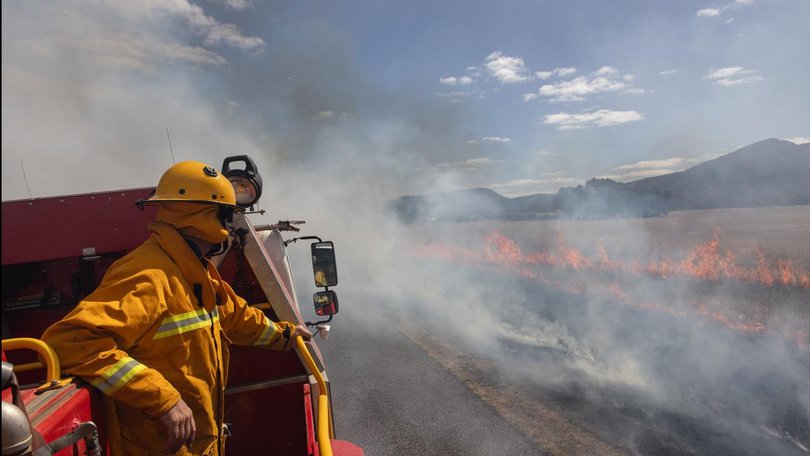Victoria bushfires: Race against time in fight to save towns in path of inferno disaster

Driving through smoke as heat radiates through fire trucks and flames lap at the road, Country Fire Authority members know they are in a race against time.
Giant plumes of smoke billow from the Grampians National Park in the distance but their presence looms large over the 80-odd volunteers making fire breaks to protect nearby communities in Victoria’s west.
Crews hose down trees before men on quad bikes light controlled fires, with orange flames quickly turning metre-high grassland into black stubble as trailing crews douse the area with water.
Sign up to The Nightly's newsletters.
Get the first look at the digital newspaper, curated daily stories and breaking headlines delivered to your inbox.
By continuing you agree to our Terms and Privacy Policy.This has to be completed before the mercury soars and wind changes direction at the end of the weekend.
“It’s pretty much a disaster if that fire gets to here, but this will mitigate that disaster,” Glenthompson CFA volunteer Leigh Heard told AAP.
“There’s probably not many fire breaks between there and here,” he said, pointing to the smoke plumes.
Mr Heard and fellow Glenthompson CFA volunteer Russell Mitchell were among CFA crews who answered a call to urgently carry out fuel reduction burns southwest of the Grampians before stifling conditions set in.
The nearby bushfire in the national park has grown substantially, with a wind change expected in coming days meaning flames could spread out of the mountains and towards communities.
Both that fire and another out-of-control blaze at the northern end of the national park were sparked when 10,000 dry lightning strikes hit Victoria, with fears the two could meet and burn for weeks.
Authorities realised a fire break was urgently needed on the main road between the towns of Cavendish and Dunkeld.
“Because it’s an emergency situation it’s quickly put together and there’s stacks of trucks and people and personnel, everybody’s sort of pulling together to get this done,” Mr Mitchell said.
This time the Glenthompson unit is “tail-end Charlie” - the truck at the back of the convoy, with Mr Heard behind the wheel and Mr Mitchell putting out smouldering debris.
Against a background of radio chatter, a “woosh” sound is audible from inside the cabin as water hits the most intense flames.
Their own town was under evacuation orders at Christmas, when a fire lasting about three weeks reached land belonging to Mr Mitchell’s neighbours.
“When we’re under threat, people from other regions come and help us,” he said.
“So then when they’re in a bit of strife, we can go and help them, so it works both ways.”
It’s a similar story at the northern Grampians fire, with CFA crews back-burning what they could before surrounding downs were evacuated earlier in the week.
Residents are waiting nervously to see what the next few days brings, frequently checking in with each other and staying glued to emergency apps.
The national park remains closed, with the fires wiping out vast amounts of wildlife.
Victoria’s richest concentration of Indigenous rock art inside the park is under threat, while it’s also been a major blow to local businesses in an area popular with holiday-makers over summer.
It’s been a testing week for many communities across the state’s west, with a separate out-of-control bushfire earlier threatening the town Dimboola further north.
Locals there were given just 30 minutes to evacuate as flames quickly grew in high winds, reaching about 70,000 hectares in just 24 hours.
Two homes, an event centre and much private land was destroyed by that fire which is now in the Little Desert National Park, with Dimboola residents thankful CFA members protected the town.
Some 700 firefighters are battling all three fires in what has been a “really, really trying” year for crews, according to Mr Mitchell who joined the service at 16.
“It seems to be happening on a more regular basis. When I was a kid, the Grampians really didn’t burn very often,” he said.
Frustrations about restrictions on fuel reduction burns due to conservation efforts often pop up across the region, along with anger about politics and bureaucracy getting involved in the CFA’s work.
Who will fight those fires in the future is proving the biggest concern of them all.
Like many other small towns around the nation, Glenthompson no longer has a school and fewer shops than ever as many residents’ children leave and fewer people move in.
“They’ll have a problem in years to come,” Mr Heard said.
Mr Mitchell agrees, saying fewer volunteers and the ageing population will put an even bigger strain on whoever stays in the area.
One potential solution is combining volunteer brigades, with some doubting how the state would pay for a such a big expansion of professional firefighters.
Local units will continue to cover each other for now, but there’s no guarantee this back-burning outside of Dunkeld will entirely stop the flames.
It should slow them down enough for crews to get on top of them, with several people wryly suggesting it should be known as a fire brake, not break.
If the fire reaches this spot early next week, local crews will be back to attack it, but a skeleton crew will remain behind at Glenthompson - just in case.
“A lightning strike can come in right on our place, even if we burn everything between us and the mountains,” Mr Heard said.
“You’re constantly aware of fire and you’re aware of the danger.”
Conditions can also change quickly, with thousands of CFA crews on alert across much of the nation with heatwave warnings in several states.
“That’s Australia, isn’t it? We’re one of the most fire prone areas but when it happens like this, it happens ... but it’s still pretty sad and confronting too,” Mr Mitchell said.
